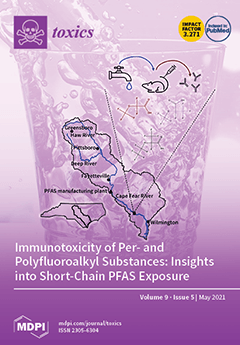Iodine deficiency is the main environmental factor leading to thyroid cancer. At the same time iodine excess may also contribute to thyroid cancer. Potassium iodate (KIO
3), which is broadly used in salt iodization program, may increase oxidative damage to membrane lipids
[...] Read more.
Iodine deficiency is the main environmental factor leading to thyroid cancer. At the same time iodine excess may also contribute to thyroid cancer. Potassium iodate (KIO
3), which is broadly used in salt iodization program, may increase oxidative damage to membrane lipids (lipid peroxidation, LPO) under experimental conditions, with the strongest damaging effect at KIO
3 concentration of ~10 mM (corresponding to physiological iodine concentration in the thyroid). Melatonin and indole-3-propionic acid (IPA) are effective antioxidative indoles, each of which protects against KIO
3-induced LPO in the thyroid. The study aims to check if melatonin used together with IPA (in their highest achievable in vitro concentrations) reveals stronger protective effects against KIO
3-induced LPO in porcine thyroid homogenates than each of these antioxidants used separately. Homogenates were incubated in the presence of KIO
3 (200; 100; 50; 25; 20; 15; 10; 7.5; 5.0; 2.5; 1.25; 0.0 mM) without/with melatonin (5 mM) or without/with IPA (10 mM) or without/with melatonin + IPA, and then, to further clarify the narrow range of KIO
3 concentrations, against which melatonin + IPA reveal cumulative protective effects, the following KIO
3 concentrations were used: 20; 18.75; 17.5; 16.25; 15; 13.75; 12.5; 11.25; 10; 8.75; 7.5; 0.0 mM. Malondialdehyde + 4-hydroxyalkenals (MDA + 4-HDA) concentration (LPO index) was measured spectrophotometrically. Protective effects of melatonin + IPA were stronger than those revealed by each antioxidant used separately, but only when LPO was induced by KIO
3 in concentrations from 18.75 mM to 8.75 mM, corresponding to physiological iodine concentration in the thyroid. In conclusion, melatonin and indole-3-propionic acid exert cumulative protective effects against oxidative damage caused by KIO
3, when this prooxidant is used in concentrations close to physiological iodine concentrations in the thyroid. Therefore, the simultaneous administration of these two indoles should be considered to prevent more effectively oxidative damage (and thereby thyroid cancer formation) caused by iodine compounds applied in iodine prophylaxis.
Full article






